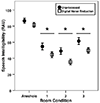Interactions Between Digital Noise Reduction and Reverberation: Acoustic and Behavioral Effects
- PMID: 31267958
- PMCID: PMC7416503
- DOI: 10.3766/jaaa.18048
Interactions Between Digital Noise Reduction and Reverberation: Acoustic and Behavioral Effects
Abstract
Background: Digital noise reduction (DNR) processing is used in hearing aids to enhance perception in noise by classifying and suppressing the noise acoustics. However, the efficacy of DNR processing is not known under reverberant conditions where the speech-in-noise acoustics are further degraded by reverberation.
Purpose: The purpose of this study was to investigate acoustic and perceptual effects of DNR processing across a range of reverberant conditions for individuals with hearing impairment.
Research design: This study used an experimental design to investigate the effects of varying reverberation on speech-in-noise processed with DNR.
Study sample: Twenty-six listeners with mild-to-moderate sensorineural hearing impairment participated in the study.
Data collection and analysis: Speech stimuli were combined with unmodulated broadband noise at several signal-to-noise ratios (SNRs). A range of reverberant conditions with realistic parameters were simulated, as well as an anechoic control condition without reverberation. Reverberant speech-in-noise signals were processed using a spectral subtraction DNR simulation. Signals were acoustically analyzed using a phase inversion technique to quantify improvement in SNR as a result of DNR processing. Sentence intelligibility and subjective ratings of listening effort, speech naturalness, and background noise comfort were examined with and without DNR processing across the conditions.
Results: Improvement in SNR was greatest in the anechoic control condition and decreased as the ratio of direct to reverberant energy decreased. There was no significant effect of DNR processing on speech intelligibility in the anechoic control condition, but there was a significant decrease in speech intelligibility with DNR processing in all of the reverberant conditions. Subjectively, listeners reported greater listening effort and lower speech naturalness with DNR processing in some of the reverberant conditions. Listeners reported higher background noise comfort with DNR processing only in the anechoic control condition.
Conclusions: Results suggest that reverberation affects DNR processing using a spectral subtraction algorithm in such a way that decreases the ability of DNR to reduce noise without distorting the speech acoustics. Overall, DNR processing may be most beneficial in environments with little reverberation and that the use of DNR processing in highly reverberant environments may actually produce adverse perceptual effects. Further research is warranted using commercial hearing aids in realistic reverberant environments.
American Academy of Audiology.
Figures






Similar articles
-
The Effects of Signal to Noise Ratio, T60 , Wide-Dynamic Range Compression Speed, and Digital Noise Reduction in a Virtual Restaurant Setting.Ear Hear. 2024 May-Jun 01;45(3):760-774. doi: 10.1097/AUD.0000000000001469. Epub 2024 Jan 23. Ear Hear. 2024. PMID: 38254265 Free PMC article.
-
The influence of audiovisual ceiling performance on the relationship between reverberation and directional benefit: perception and prediction.Ear Hear. 2012 Sep-Oct;33(5):604-14. doi: 10.1097/AUD.0b013e31825641e4. Ear Hear. 2012. PMID: 22677815
-
Listener Factors Associated with Individual Susceptibility to Reverberation.J Am Acad Audiol. 2018 Jan;29(1):73-82. doi: 10.3766/jaaa.16168. J Am Acad Audiol. 2018. PMID: 29309025 Free PMC article.
-
Effects of reverberation and noise on speech intelligibility in normal-hearing and aided hearing-impaired listeners.J Acoust Soc Am. 2018 Mar;143(3):1523. doi: 10.1121/1.5026788. J Acoust Soc Am. 2018. PMID: 29604671
-
A Scoping Review of the Effect of Classroom Acoustic Conditions on University Students' Listening, Learning, and Well-Being.J Speech Lang Hear Res. 2023 Nov 9;66(11):4653-4672. doi: 10.1044/2023_JSLHR-23-00154. Epub 2023 Sep 21. J Speech Lang Hear Res. 2023. PMID: 37734163
Cited by
-
The Effects of Signal to Noise Ratio, T60 , Wide-Dynamic Range Compression Speed, and Digital Noise Reduction in a Virtual Restaurant Setting.Ear Hear. 2024 May-Jun 01;45(3):760-774. doi: 10.1097/AUD.0000000000001469. Epub 2024 Jan 23. Ear Hear. 2024. PMID: 38254265 Free PMC article.
-
Binaural speech intelligibility for combinations of noise, reverberation, and hearing-aid signal processing.PLoS One. 2025 Jan 15;20(1):e0317266. doi: 10.1371/journal.pone.0317266. eCollection 2025. PLoS One. 2025. PMID: 39813264 Free PMC article.
References
-
- Alcántara JI, Moore BC, Kühnel V, & Launer S (2003). Evaluation of the noise reduction system in a commercial digital hearing aid: Evaluación del sistema de reducción de ruido en un auxiliar auditivo digital comercial. Int J Audiol, 42(1), 34–42. - PubMed
-
- Allen JB, & Berkley DA (1979). Image method for efficiently simulating small‐room acoustics. J Acoust Soc Am, 65(4), 943–950.
-
- Arehart KH, Hansen JH, Gallant S, & Kalstein L (2003). Evaluation of an auditory masked threshold noise suppression algorithm in normal-hearing and hearing-impaired listeners. Speech Comm, 40(4), 575–592.
-
- Arslan L, McCree A, & Viswanathan V (1995, May). New methods for adaptive noise suppression. In Acoust, Speech, Signal Process, 1995. ICASSP-95., 1995 Int Conf on (Vol. 1, pp. 812–815). IEEE.
Publication types
MeSH terms
Grants and funding
LinkOut - more resources
Full Text Sources
Other Literature Sources
Medical

